As reported on the main page we have had a solar power system for several years. The solar system has been in place for billions of years. All that untapped energy…
Poor joke, but we have been claiming some of Sol’s output since February 2013. Not a long time in the scheme of things. Sol’s output is estimated at equivalent of 384.6 septillion watts (3.846×1026 W per second). To put that in perspective, this is the equivalent of about 9.192×1010 megatons of TNT per second, or 1,820,000,000 Tsar Bombas – the most powerful thermonuclear bomb ever built! A lot of energy we are not using. More detail here
We have a south facing roof. Paarl Energy installed the 14 x 250w panels, the inverter in the loft and the Apollo-Gem Immersion heater for our hot water tank. They wired up the distribution board electrics to and set up the Owl.
The system has a max generating capacity of 3.5 kilowatt hours. That’s dependent on light, and sunshine but not heat. Light means daylight. The panels are steep enough that we’ve not had many problems with rare snow. Rain keeps them fairly clean.
They could probably do with a clean but access is not easy for the top panels. Our roof is steep and high. The panel numbers were limited by roof space and the professional advice to not go right out to the edge.
Solar Installation
The panels are in multiple rows 4 (two not shown), then 2×2 at lowest level then two rows of 4. They are mounts on spacers above the tiles. Installation took several hours spread over a couple of days. Panels shown below – yes they are dirty despite the rain.
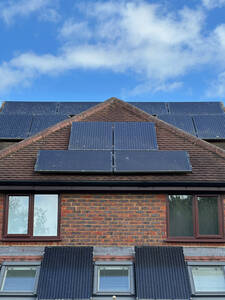
Solar Power System
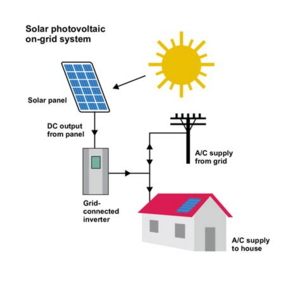
Panels
Panasonic 250 Watt or Conergy 250 watt – can’t remember which actually got installed. Invoice doesn’t say. Anyway we were going to have 16 but could only get 14 on roof safely. Wish we had more. Have also looked at replacing with higher capacity now available but that would stop our Feed In Tariff, see below. I can see 575 watt 14 replacement panels available for only £2,000 plus installation. Tempting. The panels do get hot by the way. Don’t clean when they are running on bright day, not that we can reach top ones.
Almost as tempting as installing a Tesla roof which has solar tiles. why aren’t these being rolled out for all new house builds? Okay cost but…
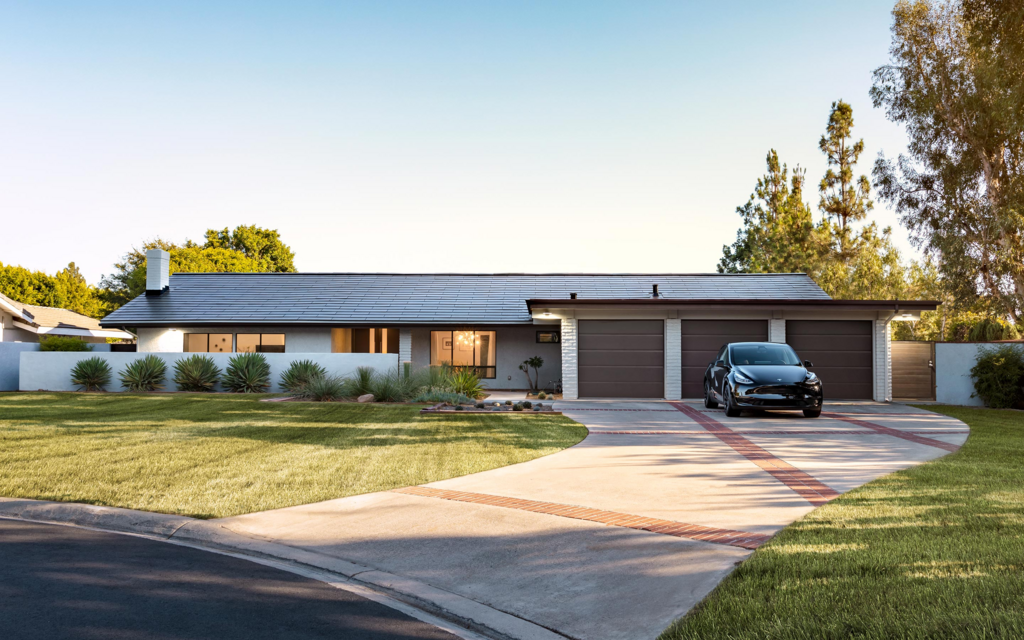
Inverter – Samil Power
Samil SolarRiver-D PV Grid-tied inverter

Immersion – Apollo GEM

Added to the diagram in our system is the immersion heater. This uses solar to heat the hot water tank. Not the heating (we have gas). Of course if we used a heat pump we could be all electric. The heat pumps are expensive, noisy and ugly. Government grants are available but they fail to cover the complete costs especially, the extra radiators needed. I’ve seen costs as high as £18,000 for a similar sized house to ours. Electric is more expensive than gas on many tariffs. Think there is a long way to go on this. That’s if you have a suitable wall and space and the money…

It’s also worth noting and sometimes misunderstood that without a battery the system needs mains power to work. So in the event of a power cut we can’t use the solar power. It does seem counter-intuitive. another reason for a battery!
Solar – Owl Intuition
Monitoring our system (aside from the main meter in the garage) is a small sub-system from Owl Intuition. This consists of a wi-fi receiver monitoring unit (centre) which connects to a clamp on the solar mains feed in the garage which is linked to the bottom right battery powered sender. The monitoring outputs to their software page and app.

The app is on mobiles as well as a fuller web page. There you can add financial information and costs for consumption. Main display below. At this time we were doing our first home charging of the car via a normal mains plug with a limit set to 6 amps. It’s configurable in the Tesla app The dishwasher was going. As you can see generation was only 1.8kw/h and we were still exporting to the grid despite the sun being intermittent.
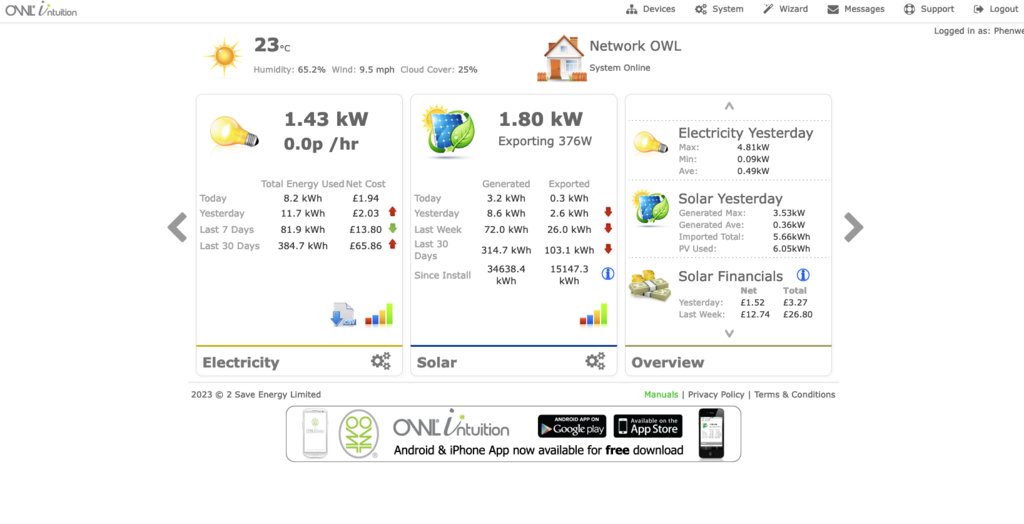
The charts on the app allow further analysis of other historical data by power and cost
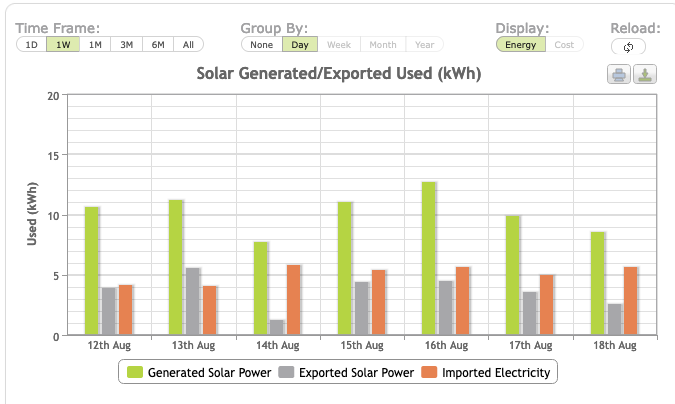
Solar Power – Feed In Tariff
Because of when we purchased the system the government was still offering feed in tariff benefits. This scheme is no longer available but still pays out. Rates are complex covering different generation methods and when system was installed. We get 15.4p per kw/h generated, which is assessed at 50% of capability i.e. it’s not actual generation. We have to provide a reading to EDF each quarter – not smart metered, and we get 50% of that at 15.4p. More in summer quarters than in winter.
The scheme has now been replaced with the Smart Export Guarantee. It’s just as confusing; as FIT however some energy suppliers can do real time monitoring and payments/costs adjusted every 30 minutes via suitable Smart meter.
We can’t do both even if we wanted to. Nor can we get more by increasing capacity with higher rated panels or adding more panels on front of house. I still get annoyed on summer mornings when our panels are in shadow and the front is scorching – all wasted energy.
Costs
The not $1 million question. We wanted to help go green not just save money. Our system cost £6,200 in 2013 equivalent to £8,300 now.
FIT
FIT payments vary hugely but add up to about £450 per year (that was 2022-23 amount) so 13 years Return on Investment (ROI) just on FIT. We’re at ten-and-a-half years so far (August 2023).
ROI Calculation
Impossible to calculate is the reduced energy consumption cost even with the Owl App. Sometimes it has stopped monitoring (batteries in sender) or wi-fi issues. In a good summer, not 2023 obviously except June, we sometimes use no electricity from the grid during the day. Of course we still get standing charges. Checking Owl it claims £6,000 of generated power out of £9,000 used in the 10 years. Add that to FIT and we have £10,500 return on that £6,200 investment. Of course rates have changed over that period, hence another variable.
I’ve ignored maintenance costs because we haven’t had any. We had a couple of trips. We had a hot water tank replaced (not the immersion). Our inverter is still going – if we go to a battery it will be changed.
Behaviour
We also have to consider how our behaviour has changed all power use. LED lights, use of appliances. The appliances themselves. Those ratings mean something. Even things like working form home and number of people living there, Now children have flown its just us two and one or more dogs!
It’s almost impossible to calculate more accurately. That said, there is a great buzz when we are not paying for electricity. Mind you suppliers still charge standing charge which they have increased ahead of inflation too.
Weather and Daylight – The sun again
Bright clear winter days are great. No electricity use on a freezing January day is a very happy feeling. Dull days anytime of year are not. Clearly our Northern Hemisphere latitude gives long daylight from 21st March to 21st September (the equinoxes) with the peak on Summer Solstice of 21st June and shorter daylight in our winter worst daylight 21st December. Weather changes all those calculations, but 21st June in London (we’re just South) gives 16 hours and 49 minutes of daylight. Remember shadow comments above.
Our best generation time is actually around 15:00 BST or Alpha. You can feel the house get going.

